Hmong Ground Beef Stew Usually at Hmong Weddings
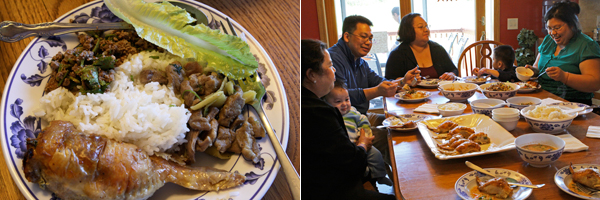
"The clan is the cornerstone of the Hmong Community," says Dara Kasouaher. Kasouaher, who is Hmong, was born in Milwaukee, WI. Her younger brother was also born in the US, but her parents and three elder sisters immigrated in August 1976. According to the 2006 American Community Survey, there are approximately 88,000 Hmong living in Minnesota and Wisconsin. Kasouaher's sister, Maykao Hang, says there are 18 clans living in Minnesota.
Cooking for extended family is an important part of everyday life for the Hmong. Hang describes one family meal that required "nine racks of ribs from Sam's Club, just to prepare one dish." Laughing, she says: "There's a reason I have a pot so large I can fit my four-year-old in."
A new cookbook by Sami Scripter and Sheng Yang called Cooking from the Heart: The Hmong Kitchen in America provides context for local Hmong cooking (look for the Heavy Table's review of the book on Friday, May 22). When the Hmong fled "Indochina, mostly… the mountains of Cambodia, Laos, Thailand, and Vietnam"…"they brought to their new homes a simple, earthy cuisine and cooking traditions that reflected a rural lifestyle and ancient culture."

The Heavy Table wanted to get a better sense of Hmong home cooking, so we asked Kasouaher if we could spend a day cooking with her. She enthusiastically agreed, but added: "In order to experience real Hmong cooking, you need a large group of women cooking together." She rounded up her mother, Sua Yang, and her sisters Maykao Hang and Naly Yang (her eldest sister has returned to Laos) for a day of cooking in Hang's home in Woodbury, MN. "This is what we do on weekends anyway," Kasouaher says. While we shopped and cooked, their husbands and young children entertained themselves in the yard, playing with rubber-band jump ropes they'd made themselves, and occasionally stopping in the kitchen to help chop cilantro or beef or to snack on a sliver of green papaya.
Our Hmong hosts made a shopping trip to Cub Foods for pork and beef before we arrived, so our day of Hmong cooking began at the International Market Place "flea market" at 217 Como Ave. in St. Paul, near the Capitol. The market doesn't look like much from the street — a loose collection of seemingly unrelated warehouse buildings and open-air stalls (including, in season, a farmers' produce market), united by a parking lot pitted with potholes. But, stepping into any of the buildings makes you feel as if you've wandered out of St. Paul and into a market in Southeast Asia. "This is just like the markets in Laos or Thailand," says Kasouaher, "except that the floors are not dirt."

Vendors' tables are heaped with medicinal roots, Ziploc baggies of seeds, glass cases of silver jewelry, enormous rice cookers, folk art, and ornately stitched and beaded Hmong clothing in bright pinks and greens. The aisles are crowded with people studying the vendors' wares and conversing in Hmong. Occasionally a strain of Hmong music from stalls selling DVDs overtakes the chatter of the crowd. Some vendors sell handcrafted knives and gardening tools. "Crafting steel is a family trade in Laos," says Kasouaher, "passed down father to son." "These are the best, very sharp," said Hang as she examined the blade of a hoe. "But, like any flea market anywhere, if you see something you like, buy it right away. It may not be there if you come back." She turned to the woman tending the booth and, in Hmong, proceeded to negotiate the purchase of the hoe.

In a building at the back, vendors sell produce such as greens, herbs, lemongrass, lychees, and longans, year-round. This time of year, the outdoor produce vendors sell seedlings for Hmong herbs. "Hmong people do a lot of gardening," says Kasouaher. "It's ingrained to grow your own stuff. Use what you can, then give the rest to family." Sweeping her hand over orderly rows of potted seedlings, $2 each, Hang says, 'These are all chicken herbs," referring to a recipe that I'd inquired about, "Fresh Chicken with Hmong Herbs (Soup for New Mothers)" in Scripter and Yang's "Cooking from the Heart." According to the book, "Hmong custom dictates that, for one month after a baby is born, a mother's diet consist of only this chicken soup, freshly cooked rice, and the warm water drained from the second soaking of rice (kua ntxhai) or clear, warm water." Kasouaher says that in Laos it could be a big sacrifice for a family to feed a new mother the chicken soup for a month. "It's a great sign of respect for her daughter-in-law, for a mother-in-law to make the chicken soup for her," she says. "It is a time for a husband to show how he cares for his wife by making the chicken soup, often reserving for her the best parts of the chicken."
Says Hang, "You don't have to have a child to have the chicken." You can eat the soup anytime. (We'll include the "Fresh Chicken with Hmong Herbs (Soup for New Mothers)" recipe in Friday's review of "Cooking from the Heart").
In the cookbook, the authors describe how many chicken herbs, which can't be found in the typical American grocery store, "originated from seeds and starts carefully brought to the United States from Laos in the handbags and pockets of Hmong women striving to preserve their healthy cooking traditions."
According to Hang, today she has access in Minnesota to all of the ingredients and equipment she needs for traditional Hmong cooking. "At first, it was hard to find ingredients, but as more Hmong immigrated, they brought more of the seeds for the herbs with them… Now, you can get everything you need. You can even find some at Cub."
On our way out of the market we stopped at the food court, which is a collection of half a dozen food booths at the back of the building that is on the left as you enter the market. "This is real Hmong food, if you want to try it without cooking," says Hang. "It's amazing, and it's always changing." She walks up to one stall, Coco's Island, and gestures at the whole fish in the deli case. "Today there's whole fried tilapia, with sauces that you pour on after it's cooked so that the flavors are more vibrant. There are cabbage rolls, which have the same filling as egg rolls and are steamed in a rice cooker." Another variation on egg rolls, stuffed chicken wings, was on our lunch menu later in the day.
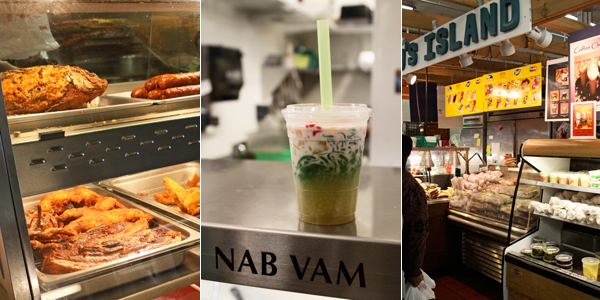
Kasouaher nods at a stall and says, "This is the closest you get to a Hmong dessert. " Nab vam, [pronounced na va] which is a sweet drink made of a simple syrup of caramelized sugar, coconut milk, ice, and tapioca pearls, comes in as many different colors as a box of Crayolas. "They put as many colors as they can, so it looks pretty. It's best on a hot summer day." ("Cooking from the Heart" includes a couple of recipes for Nab Vam "Three-Color Dessert," in case you are ambitious enough to make it at home.)
Our next stop was Dragon Star Oriental Foods at 633 Minnehaha Ave. W in St. Paul, where we picked up greens of all sorts, fresh tofu (from the deli in back), seasoning packets for the larb (the Hmong version of a wrap), and green papaya. In addition to everything we would need for cooking several Hmong dishes, Dragon Star also carries African, Mexican, and Middle Eastern groceries, which reflects the diversity of the Frogtown neighborhood in which it is located. Kasouaher had planned that we'd do some of our shopping at a Hmong market,Golden Harvest F00ds at 900 Maryland Ave. E in St. Paul, except that Hang prefers the selection of green papaya at Dragon Star. Says Hang: "You don't want the round ones, as they tend to be hollow inside. Get the long ones, even if they're small. They have more flesh." Hang also recommends the seafood at Dragon Star. "Fresh seafood plays a big role in the Hmong diet," she says.
Once we arrived back at Hang's house with our groceries, the four women quietly divided up cooking tasks, with Hang tackling the preparation of a curry noodle soup (pictured above) to fortify us while we prepared the day's big meal. "It's not unusual," says Hang, "to eat a small snack during a day of cooking."

In "Cooking from the Heart," Scripter and Sheng write: "Hmong cooks don't use measuring cups or spoons when making old standards, so such implements are often not found in Hmong kitchens… Good Hmong cooks learned from their elders which ingredients to use, and how much of each, by sight, feel, and taste." At no point during our day did any of the women refer to a recipe or cookbook. Even Kasouaher's brother in-law, who made the larb, prepared the dish entirely from taste and memory. (Kasouaher says that Hmong men customarily prepare larb similar to how American men might barbeque.) Kasouaher had planned to write down the recipe for her Hmong pork with ginger for me, but once she started, decided against it. "It's so simple," she said, "I'll just show you." And she did. (Kasouaher's recipe, as observed by me, appears at the end of this article.)
The ideal Hmong meal, according to Hang, would include a palate cleanser with liquid, such as fresh tofu in its own liquid, or a boiled vegetable such as chayote squash in water; steamed rice; a meat dish; a fried vegetable dish; and a condiment of mashed chili, pepper, lime juice, and fish sauce.
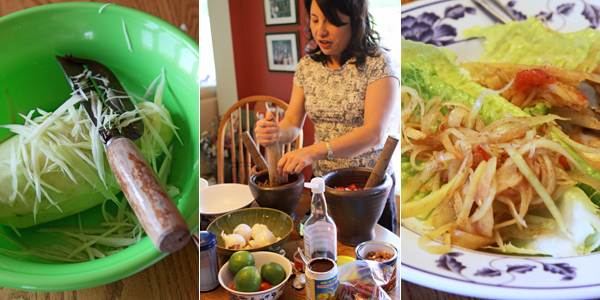
In addition to the Hmong pork with ginger, our meal included a palate cleanser of fresh tofu, which was fresh and earthy, and another of sliced chayote squash served in the water in which it was boiled. The pale green color of a honeydew melon, it was faintly sweet. We also had green papaya salad (see recipe below), which Hang had pounded out in two mortars and pestles, the larger one for spicy salad, and the smaller one for mild salad (fewer or no peppers) for the children. Hang set out a miniature mortar and pestle for her four year old, who sometimes likes to who help with cooking.
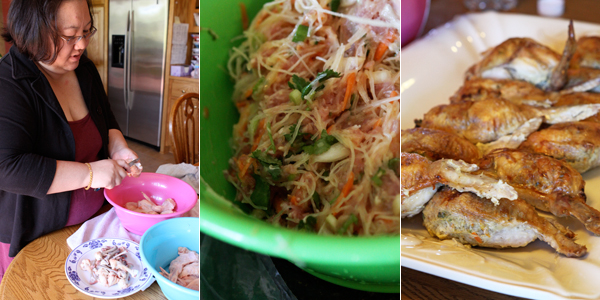
Stuffed chicken wings, according to Naly Yang, is a variation on the egg roll where the filling of vermicelli noodles, ground pork, and spices is packed into a deboned chicken wing to the point where you worry the skin might burst, then baked in an oven until the filling is heated through and the skin is a crispy and golden brown. The dish is labor intensive, and the deboning technique takes some skill and patience, as Yang showed us in this video. However, the results are splendid. If you are a patient cook, look for the stuffed chicken wing recipe in "Cooking from the Heart."
Larb (pronounced lob), is the Laotian version of a wrap: chopped or ground meat is combined with spices and herbs, cooled to room temperature, and served wrapped in a lettuce leaf. (We'll include a larb recipe in Friday's review of "Cooking from the Heart").
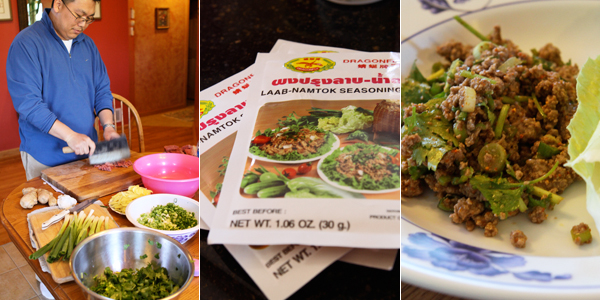
At the end of the meal, Hang said, "Once you have shared a meal with a Hmong family, you are family. Stop by anytime. You don't even have to call ahead."
***
Hmong Pork with Ginger (ntxuas, which literally means "with")
Either this dish, or larb, is traditionally served at funerals, birth celebrations, or weddings to help absorb some of the alcohol in the spirits that are imbibed as part of the ceremony.
As this recipe is prepared to taste, there are no specific measurements. You can make as a much or as little as you like, depending on your needs. The amount of ginger you need should be about one-third of the amount of pork.
Vegetable oil for stir frying
Pork shoulder steak, trimmed of some — but not all — fat and sliced into bite-sized pieces
Salt
Black pepper
Ginger root, peeled and sliced (lots of ginger, enough to make it the co-star of the dish) — proportion relative to pork is one-third
Green onion, whites and greens sliced
Cilantro, chopped
Heat vegetable oil in a wok over high heat. Add sliced pork; season with salt and pepper. Stir frequently. When pork is browned, add ginger and continue to stir fry until fragrant. Add green onion and chopped cilantro to taste. Serve with steamed rice.
Sheng's Green Papaya Salad (See Taub Ntoos Qaub)
Hang says, "Americans eat potato chips. Hmong eat papaya salad. It's available from vendors on street corners in Laos and Thailand." You need a large mortar and pestle and a papaya shredding tool to prepare this recipe. When selecting your mortar and pestle, make sure the pestle fits nicely at the bottom of the mortar. Hang has made it with carrots or cucumber instead of papaya. She also includes dry roasted peanuts in her recipe. The consistency should be a little liquidy and the taste a balance of sour, sweet, spicy, and a little salty. Hang eats hers wrapped in a fresh romaine lettuce leaf.
Recipe below has been excerpted from Cooking from the Heart: The Hmong Kitchen in America by Sami Scripter and Sheng Yang
Makes about 6 servings
This salad, a Hmong favorite, can be made with green papaya or shredded carrots. Sheng Yang prepared it with carrots the day she came to live with the Scripters in 1980. For non-Hmong people, the combination of flavors is definitely an acquired taste. Sheng always includes MSG in papaya salad, although it can be omitted. Shrimp and crab paste have strong fishy flavors, and although they are essential to Hmong papaya salad, a non-Hmong may want to taste some before including the full amount called for in this recipe.
4 c shredded green papaya or 4 medium-sized carrots
2 to 4 cloves garlic (depending upon your taste — some people like it very garlicky)
1 to 3 hot Thai chili peppers (depending upon desired heat)
1 to 2 tbsp fish sauce
½ tbsp shrimp paste (optional)
½ tbsp crab paste (optional)
1 tbsp sugar
1 tsp MSG (optional)
Juice and some of the pulp of 1 lime
6 cherry tomatoes
3 c shredded cabbage
Some Asian markets sell shredded green papaya, or you can shred it yourself after peeling using a special tool, also available in Asian markets. If preparing this dish with carrots, scrub them well and cut off the top ends. Peel them into long, thin strips with a vegetable peeler and set them aside. Remove the papery skin from the garlic cloves and put the cloves in a large mortar. Remove the stem ends of the chilies and add the chilies to the garlic. With a pestle, pound the garlic and chilies until they are mushy. Next, add the green papaya or carrot strips, fish sauce, shrimp and crab paste (if desired), sugar, and MSG (if desired). Squeeze the lime juice into the mixture, discarding the seeds. Use a spoon to scrape some of the lime pulp into the salad. Pound together a minute or two, turning the mixture over with a spoon. Continue until the flavors are extracted and mixed, but the papaya strips or carrots still retain their shape.
Cut the cherry tomatoes into quarters, and mix them into the salad. Put 1/2 cup of the cabbage on each of 6 individual salad plates and top with the salad mixture.
RESOURCES:
Groceries and produce:
International Market Place
217 Como Ave. (near Marion St.)
St. Paul, MN 55103
651.487.3700
Dragon Star Oriental Foods
633 Minnehaha Ave. W
St. Paul, MN 55104
651.488.2567
Golden Harvest Foods
900 Maryland Ave. E
St. Paul, MN 55106
651.772.3200
Equipment:
International Market Place (for knives, papaya peeler, gardening tools)
Shuang Hur (for a mortar and pestle)
654 University Ave. W
St. Paul, MN 55104
651.292.1325
Golden Harvest Foods
Cub Foods (for papaya peeler)
1440 University Ave. W
St. Paul, MN 55104
651.646.8858
Prepared Hmong food (if you want to try it without having to cook):
Food Court at the International Market Place
Bright Star Market (for papaya salad)
1181 Prosperity Ave. (near Maryland)
St. Paul, MN 55106
651.771.3062
Maly's Asian Deli (restaurant and catering)
371 University Ave.
St. Paul, MN 55104
651.222.2823
Recipes:
Cooking from the Heart: The Hmong Kitchen in America by Sami Scripter and Sheng Yang
Recommended recipes: Stuffed Chicken Wings, Chicken Curry Noodle Soup, Larb (several variations), Chicken Soup for New Mothers
Hmong Culture:
Hmong Cultural Center
995 University Ave. W, Suite 214
St. Paul, MN 55104
651.917.9937
*For more photos, use this link to the Heavy Table's photostream on Flickr.
Many thanks to Sua Yang, Dara Kasouaher, Maykao Hang, and Naly Yang and their families for sharing their day, traditions, and recipes with us.
williamsreartiong.blogspot.com
Source: https://heavytable.com/a-day-in-the-kitchen-of-a-hmong-family/
0 Response to "Hmong Ground Beef Stew Usually at Hmong Weddings"
Post a Comment